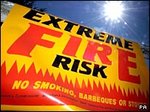European and Australasian Classifications
In Europe and Australasia, a different classification system is used.
* Class A: Fires that involve flammable solids such as wood, cloth, rubber, paper, and some types of plastics.
* Class B: Fires that involve flammable liquids or liquifiable solids such as petrol/gasoline, oil, paint, some waxes & plastics, but not cooking fats or oils.
* Class C: Fires that involve flammable gases, such as natural gas, hydrogen, propane, butane.
* Class D: Fires that involve combustible metals, such as sodium, magnesium, and potassium.
* Class E: Fires that involve any of the materials found in Class A and B fires, but with the introduction of an electrical appliances, wiring, or other electrically energized objects in the vicinity of the fire, with a resultant electrical shock risk if a conductive agent is used to control the fire.
* Class F: Fires involving cooking fats and oils. The high temperature of the oils when on fire far exceeds that of other flammable liquids making normal extinguishing agents ineffective.
The system is more or less the same as the U.S system, with letter designations shifted around - for instance, Class C fires in the U.S system are known as Class E in Europe.
By Wikipedia
In Europe and Australasia, a different classification system is used.
* Class A: Fires that involve flammable solids such as wood, cloth, rubber, paper, and some types of plastics.
* Class B: Fires that involve flammable liquids or liquifiable solids such as petrol/gasoline, oil, paint, some waxes & plastics, but not cooking fats or oils.
* Class C: Fires that involve flammable gases, such as natural gas, hydrogen, propane, butane.
* Class D: Fires that involve combustible metals, such as sodium, magnesium, and potassium.
* Class E: Fires that involve any of the materials found in Class A and B fires, but with the introduction of an electrical appliances, wiring, or other electrically energized objects in the vicinity of the fire, with a resultant electrical shock risk if a conductive agent is used to control the fire.
* Class F: Fires involving cooking fats and oils. The high temperature of the oils when on fire far exceeds that of other flammable liquids making normal extinguishing agents ineffective.
The system is more or less the same as the U.S system, with letter designations shifted around - for instance, Class C fires in the U.S system are known as Class E in Europe.
By Wikipedia



No comments:
Post a Comment